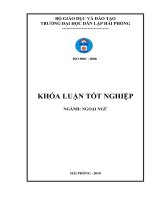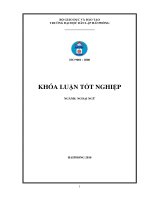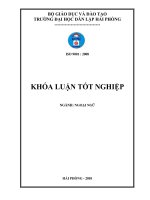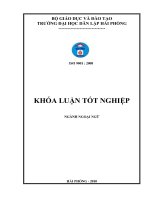A STUDY ON TRANSLATION OF TYPICAL TERMS USED IN LABOR LAW FROM VIETNAMESE INTO ENGLISH
Bạn đang xem bản rút gọn của tài liệu. Xem và tải ngay bản đầy đủ của tài liệu tại đây (534.8 KB, 71 trang )
BỘ GIÁO DỤC VÀ ĐÀO TẠO
TRƯỜNG ĐẠI HỌC DÂN LẬP HẢI PHỊNG
-------------------------------
ISO 9001 : 2008
KHĨA LUẬN TỐT NGHIỆP
NGÀNH: NGOẠI NGỮ
HẢI PHÒNG - 2010
1
HAIPHONG PRIVATE UNIVESITY
FOREIGN LANGUAGES DEPARTMENT
-----------------------------------
GRADUATION PAPER
A STUDY ON TRANSLATION OF TYPICAL TERMS
USED IN LABOR LAW
FROM VIETNAMESE INTO ENGLISH
By:
TRẦN THỊ NGỌC HÀ
Class:
NA 1002
Supervisor:
NGUYỄN THỊ PHI NGA, M.A
HAI PHONG – 2010
2
BỘ GIÁO DỤC VÀ ĐÀO TẠO
TRƯỜNG ĐẠI HỌC DÂN LẬP HẢI PHÒNG
--------------------------------------
Nhiệm vụ đề tài tốt nghiệp
Sinh viên: ............................................................Mã
số:............................
Lớp:
.............................Ngành:....................................................................
Tên đề tài:
.................................................................................................
.............................................................................................
.....
.............................................................................................
....
.............................................................................................
.....
3
Nhiệm vụ đề tài
1. Nội dung và các yêu cầu cần giải quyết trong nhiệm vụ đề tài tốt
nghiệp
( về lý luận, thực tiễn, các số liệu cần tính tốn và các bản vẽ).
……………………………………………………………………………..
……………………………………………………………………………..
……………………………………………………………………………..
……………………………………………………………………………..
……………………………………………………………………………..
……………………………………………………………………………..
……………………………………………………………………………..
……………………………………………………………………………..
2. Các số liệu cần thiết để thiết kế, tính tốn.
……………………………………………………………………………..
……………………………………………………………………………..
……………………………………………………………………………..
……………………………………………………………………………..
……………………………………………………………………………..
……………………………………………………………………………..
……………………………………………………………………………..
……………………………………………………………………………..
……………………………………………………………………………..
3. Địa điểm thực tập tốt nghiệp.
……………………………………………………………………………..
……………………………………………………………………………..
…………………………………………………………………………….
4
CÁN BỘ HƯỚNG DẪN ĐỀ TÀI
Người hướng dẫn thứ nhất:
Họ và tên:.............................................................................................
Học hàm, học vị:...................................................................................
Cơ quan công tác:.................................................................................
Nội dung hướng dẫn:............................................................................
Người hướng dẫn thứ hai:
Họ và tên:.............................................................................................
Học hàm, học vị:...................................................................................
Cơ quan công tác:.................................................................................
Nội dung hướng dẫn:............................................................................
Đề tài tốt nghiệp được giao ngày 12 tháng 04 năm 2010
Yêu cầu phải hoàn thành xong trước ngày 10 tháng 07 năm 2010
Đã nhận nhiệm vụ ĐTTN
Đã giao nhiệm vụ ĐTTN
Người hướng dẫ
Sinh viên
Hải Phòng, ngày tháng năm 2010
HIỆU TRƯỞNG
GS.TS.NGƯT Trần Hữu Nghị
PHẦN NHẬN XÉT TÓM TẮT CỦA CÁN BỘ HƯỚNG DẪN
5
1. Tinh thần thái độ của sinh viên trong quá trình làm đề tài tốt
nghiệp:
……………………………………………………………………………..
……………………………………………………………………………..
……………………………………………………………………………..
……………………………………………………………………………..
……………………………………………………………………………..
……………………………………………………………………………..
……………………………………………………………………………..
……………………………………………………………………………..
2. Đánh giá chất lượng của khóa luận (so với nội dung yêu cầu đã đề ra
trong nhiệm vụ Đ.T. T.N trên các mặt lý luận, thực tiễn, tính tốn số
liệu…):
……………………………………………………………………………..
……………………………………………………………………………..
……………………………………………………………………………..
……………………………………………………………………………..
……………………………………………………………………………..
……………………………………………………………………………..
……………………………………………………………………………..
……………………………………………………………………………..
……………………………………………………………………………..
3. Cho điểm của cán bộ hướng dẫn (ghi bằng cả số và chữ):
……………………………………………………………………………..
……………………………………………………………………………..
……………………………………………………………………………..
Hải Phòng, ngày ….. tháng ..… năm 2010
Cán bộ hướng dẫn
(họ tên và chữ ký)
6
NHẬN XÉT ĐÁNH GIÁ
CỦA NGƯỜI CHẤM PHẢN BIỆN ĐỀ TÀI TỐT NGHIỆP
1. Đánh giá chất lượng đề tài tốt nghiệp về các mặt thu thập và phân tích tài
liệu, số liệu ban đầu, giá trị lí luận và thực tiễn của đề tài.
2. Cho điểm của người chấm phản biện :
(Điểm ghi bằng số và chữ)
Ngày.......... tháng......... năm 2010
Người chấm phản biện
7
ACKNOWLEDGEMENTS
In my process of completing this research paper, I have received a lot
of help, assistance, and encouragement from my teachers, friends.
I would like to express my deepest gratitude to Mrs Nguyen Thi Phi
Nga, MA, the supervisor, who have generously given me valuable and
constructive comments, advices as well as correction of my research paper.
Next, I would like to express my gratitude to Prof, Dr Ho Trong Ngu,
MP, Standing member of the Committee for DSC – Member of Central of
Vietnam lawyers Association who given me suggestions and valuable
advices on how to shape the study.
I also offer my sincere thanks all teachers in Foreign Language
Department for their supportive lectures during four years that have provided
me with good background to do effectively my Graduation Paper.
Last but not least, my wholehearted thanks are presented to my parents
and friends for their encouragement and assistance in the process of doing
this research.
Hai Phong, June 2010
Tran Thi Ngoc Ha
8
TABLE OF CONTENTS
Acknowledgements
Table of contents
PART I: INTRODUCTION ................................................................. 1
1 Rationale of the study ...................................................................... 1
2 Scopes of the study ........................................................................... 2
3 Aims of the study ............................................................................. 2
4 Methods of the study ........................................................................ 3
5 Design of the study........................................................................... 3
PART II: DEVELOPMENT ................................................................ 5
Chapter 1: Theoretical Background ................................................... 5
1 Translation ........................................................................................ 5
1.1 Concepts of Translation and Equivalence in translation. .......... 5
1.1.1 Concepts of translation. .......................................................... 5
1.1.2 Concepts of equivalence in translation................................... 8
1.2 Types of translation. ...................................................................... 9
1.2.1 Word-to-word translation. ...................................................... 9
1.2.2 Literal translation. .................................................................. 9
1.2.3 Faithful translation. ................................................................ 9
1.2.4 Semantic translation. .............................................................. 10
1.2.5 Free translation. ...................................................................... 10
1.2.6 Idiomatic translation. ............................................................. 10
1.2.7 Communicative translation. ................................................... 11
1.3 Types of equivalence ................................................................... 11
2 Terms ................................................................................................ 13
2.1 What is a term generally ............................................................. 13
9
2.2 Types of terms ............................................................................. 13
2.3 Terms of Labor Law .................................................................... 14
Chapter II: Translation of Vietnamese Labor Law into English ..... 15
1 Collection of Vietnamese Typical Terms of Labor Law .................. 15
1.1 Terms related to work and activities ......................................... 15
1.2 Terms related to Labor Agreement ........................................... 27
1.3 Terms related to Labor Organizations....................................... 31
1.4 Terms related to Labor Allowance ............................................ 35
1.5 Terms related to Labor Insurance ............................................. 40
1.6 Other kinds of terms in Labor Law Document ......................... 43
2 Some problems in translation of Vietnamese ................................... 45
2.1 Problem in Structure .................................................................. 46
2.2 Problem in Culture .................................................................... 47
Chapter 3: Some Suggestions in translation of Vietnamese ............. 49
1 Understanding concepts of terms in Labor Law .............................. 49
2 The Importance of Culture in Translation ........................................ 50
3 The Translation Process ................................................................... 52
PART III: CONCLUSION ................................................................... 54
Reference................................................................................................. 56
Appendix ................................................................................................. 57
10
PART I: INTRODUCTION
1. Rationale of the study
Labor is the most important activity of a human being creating both material
products and social values. High labor productivity, quality and efficiency
are significant factors which determine the level of development of a
country. Anyone in the world needs labor to survive. Labor has no boundary;
labor has no age and labor for everyone. It is not only a need, but also
becomes a social regulation.
The Labor Law protects the right to work, benefits, and other rights of
worker, at that time, the legal rights and benefits of employers thereby
creating conditions for harmonious and stable labor relations. It assists a
worker to utilize his creativity and skill through his mind and body, and
protect the rights of a labor manager for the purposes of achieving high labor
productivity and effective utilization and management of labor, and
industrialization and modernization of the country. Generally, Labor Law
covers:
Industrial relations – certification of unions, labor-management
relations, collective bargaining and unfair labor practices
Workplace health and safety
Employment standards, including general holidays, annual vacations,
working hours, unjust dismissals, minimum wage, layoff procedures
and severance pay
By regulating the rights and obligations of employees and employers, labor
standards, labor utilization and management, the Labor Law not only
contributes increased production but also plays an important role in society
11
and in the legal system of the nation. According to me, although you do any
job, you still need to have a basic knowledge of Labor Law field if you want
to do that job better in the present international economic integration.
Besides, this field is also my passion and inspiration. It makes me feel highly
enthusiastic. That is the reason why I chose this topic for my graduation.
2. Scope of the study
There are many law sectors in Vietnam and the number terms in each is also
plentiful. In the limited time, I would like to focus on typical terms of Labor
Law. In the process of studying English, the researcher find difficult in
understanding and translating meanings of term in general. Because a lot of
terms are used with connected meanings, others are the same as what has
been known in common texts when converted into English. Thus, my study
is toward to basic concepts and terms used in Labor Law in Vietnam.
Hopefully, my research will partly help readers have a general overview on
typical terms of Labor Law.
3. Aims of the study
As a matter of fact that students who major translation should choose a
sphere as the strong point besides the other basic knowledge because the
amount of knowledge is endless especially in the coordination on an imp
formation age.
The aims of my study are therefore to:
- Understanding thoroughly about English terms from the viewpoint of
translation subject.
- Providing a number of terms in Labor Law.
- Suggesting readers (employees, employers …) and myself basic
knowledge of this field.
- Suggesting some solutions in translating Labor Law terms.
12
4. Method of the study
At the first time, I began to study English, I myself find that English is the
most common used language in society. I have been trying my best to study
for further fields of English. Thanks to the knowledge and experiences which
I gain from my teachers as well as reference books I had read in the process
of learning English and completed my graduation books. These are some
helpful sources:
- Internet plays an important role for me to understand definitions of
terms in English.
- Survey with questionnaire is also made to find out the feedback from
employees and employer in their work in perceiving some difficulties.
- Added more, I found lots of useful information in some books
introduction about Labor Law.
-
Specially, my study is about terms related to Labor that differ from
my major, I had to consult some experts and friends this area to have
deeper understanding.
5. Design of the study
The study falls into three parts in which the second is the most important,
that is:
The first part, INTRODUCTION, writes about rationale, scope, aims,
methods and design of the study
The second is DEVELOPMENT consisting of three chapters:
13
Chapter I:
Readers are going to approach the issue from the theoretical
background angle. In the words, they are some concepts of translation,
labor law terms.
Chapter II:
The researchers studied meanings of word used in common texts,
typical terms in Labor Law.
Chapter III:
-
Some problems and suggested solutions in translating labor law
terms.
- Concluded from the process of finishing the chapter two.
The part three, CONCLUSION, summarizes the study mentioned above and
gives some suggestions for further study.
14
PART II: DEVELOPMENT
CHAPTER I
THEORETICAL OF BACKGROUND
1.TRANSLATION.
1.1. Concepts of Translation and Equivalence in translation.
1.1.1. Concepts of translation.
Translation typically has been used to transfer from written or spoken SL
(source language) texts to equivalent written or spoken TL (target language)
texts. In general, the purpose of translation is to reproduce various kinds of
texts including religious, literary, scientific, and philosophical texts in
another language and thus making them available to wider readers.
If language was just a classification for a set of general or universal
concepts, it would be easy to translate from a SL to a TL. Furthermore, under
the circumstances the process of learning a language would be much easier
than it is actually. In this regard, Culler (1976) believes that languages are
not nomenclatures and the concepts of one language may differ radically
from those of another, since each language articulates or organizes the world
differently, and languages do not simply name categories; they articulate
their own. The conclusion likely to be drawn from what Culler (1976) wrote
is that one of the troublesome problems of translation is the disparity among
languages. The bigger the gap between the SL and the TL, the more difficult
the transfer of message from the former to the latter will be. Therefore, there
are various concepts of translation basing on the individual views. And I
have collected and studied some of them.
Translation is the interpreting of the meaning of a text and the
subsequent production of an equivalent text, likewise called a
"translation," that communicates the same message in another
15
language. The text to be translated is called the "source text," and the
language that it is to be translated into is called the "target language";
the final product is sometimes called the "target text."
_Wikipedia_
Translation is the expression in another language (or target language)
of what has been expressed in another, source language, preserving
semantic and stylistic equivalences.
_(Dubois, 1973)_
Kade (1968) defined interpreting as a form of Translation in which:
• The source-language text is presented only once and thus cannot be
reviewed or replayed, and
• The target-language text is produced under time pressure, with
little chance for correction and revision.
• Translation is the interpretation of the meaning of a written
message or text in one language (target language) from another
language (source language). The function of translation is to
make the readers of the target text able to understand the
semantic and stylistic meaning of the source text
Translation is the process of changing something that is written or
spoken into another language.
_Advanced Oxford Dictionary_
Translation is a bilingual mediated process of communication which
ordinarily aims at the production of a TL text that is functionally
equivalent to a SL text.
_Reiss, 1971:161_
16
Translation is the replacement of text material of this language
(source language) with text material of another ( target language).
_Cartford, 1965 : 20_
Translation is the process of finding a Target language equivalent for
a Source language utterance.
_Pinhhuck, 1977 : 38_
Translation is a transfer process, which aims at the transformation of
a written SL text into an optimally equivalent TL text, and which
requires the syntactic, the semantic and the pragmatic understanding
and analytical processing of the SL.
_ Wilss (1982: 3)_
Translation consists of reproducing in the receptor language the
closest natural equivalent of the source language message, first in
terms of meaning and secondly in terms of style.
_Nida (1984:83)_
Translation involves the transfer of meaning from a text in one
language into a text in another language.
_ Bell (1991:8)_
Translation is a process of communication whose objective is to
import the knowledge of the original to the foreign reader.
_Levy (1967:148)_
Translation is the act of transferring through which the content of a
text is transferred from the SL into the TL.
_ Foster (1958:1)_
17
Translation is to be understood as the process whereby a message
expressed in a specific source language is linguistically transformed in
order to be understood by readers of the target language"
_ Houbert (1998:1)_
Translation is an act of communication which attempts to relay,
across
cultural
and
linguistic
boundaries,
another
act
of
communication.
_ Hatim and Mason (1997:1)_
Translation is a text with qualities of equivalence to a prior text in
another language, such that the new text is taken as a substitute for the
original.
_David Frank (Wordpress.com)_
1.1.2. Concepts of equivalence in translation.
Equivalence-oriented translation is a procedure which replicates the
same situation as in the original, whilst using completely different
wording.
_Vinay and Darbelnet_
Translation equivalence exists between forms in a source language and
a target language if their meaning matches. In other words, translation
equivalence should answer the question “What do the speakers of this
language actually say to express the desired meaning?”
_Wayne Leman (Wordpress.com)_
Equivalence, when applied to the issue of translation, is an abstract
concept and actually refers to the equivalence relationship between the
source text and the target text.
_Asian social science (CCSE)_
18
1.2. Types of translation.
Translation can be divided into 7 types as below :
1.2.1. Word-to-word translation:
This is often demonstrated as interlinear translation, with the TL
immediately below the SL words. The SL word-order is preserved and the
words translated singly by their most common meaning, out of context.
E.g: Hanah was presented by her parent.
Hanah được tặng quà bởi bố mẹ cô ấy.
1.2.2. Literal translation:
The SL grammatical construction is converted to the nearest TL equivalents
but the lexical words are again translated singly, out of context.
E.g: My father put all whole his life – workings in this company
Cha tơi đã dành cả cuộc đời mình để làm việc trong công ty này.
1.2.3. Faithful translation:
A faithful translation is used when translators want to reproduce the precise
contextual meaning of the SL within the restriction of the TL grammatical
structures. It converts cultural words but reserves the degree of grammatical
and lexical “abnormality” in the translation. It attempts to be completely
faithful to the intentions and text-realization of the SL writer.
E.g: Tôi cho rằng bà ta sẽ không mua chiếc túi này
Faithful translation: I think that she won’t buy this bag
(It should be “I don’t think she will buy this bag”)
19
1.2.4. Semantic translation:
Semantic translation differs from faithful translation only in as far as it must
take more account of the aesthetic value of the SL text, compromising on
“meaning” where appropriate so that no assonance, word-play or repetition
jars in finished version.
E.g: “I never hear or read the name of Yarmouth but I am reminded of a
certain Saturday on the beach...”(extracted from David Copperfield by
Charles Dickens)
“Tôi không bao giờ nghe hoặc đọc đến tên 'Yarmouth' (tên một thị trấn) mà
tôi lại không nhớ đến một sáng thứ bảy nào đó trên bãi biển…” (...không
bao giờ...mà lại không...)
1.2.5. Free translation:
Free translation reproduces the matter without the manner, or the content
with out of the form of the original.
In free translation, there is a special form called “Adaption”. This is the
“freest” form of translation.
E.g: Outside, the immense sea is a deep blue. In the shade of green coconut
trees, the buildings appear like a desert oasis.
Mặt biển bên ngồi xanh mướt mát, màu xanh thẳm như chính đại dương
vẫn xanh từ hàng triệu năm không thay đổi sắc màu, còn bên trong, nép dưới
những tán dừa xanh là các khối nhà mơ màng trong nắng.
1.2.6. Idiomatic translation:
Idiomatic translation reproduces the “message” of the original but tends to
distort nuances of meaning by preferring colloquialisms and the idiom where
these do not exists in the original.
E.g:
Man proposes, God disposes
Mưu sự tại nhân, hành sự tại thiên.
20









